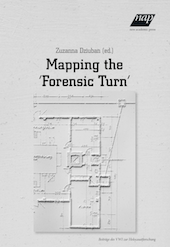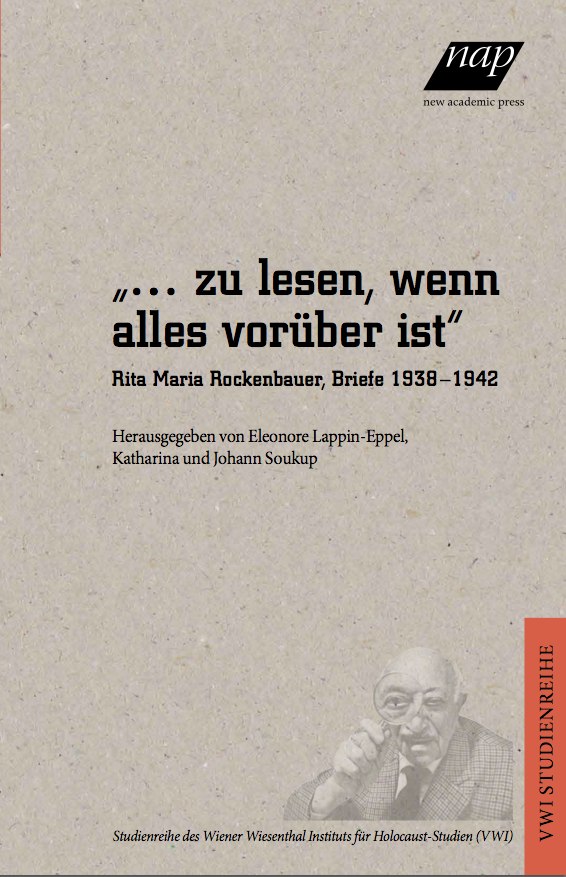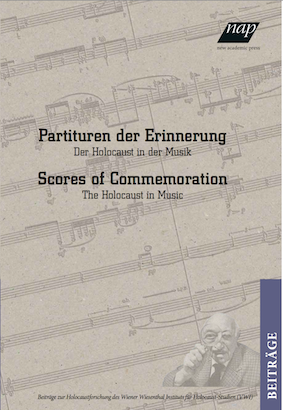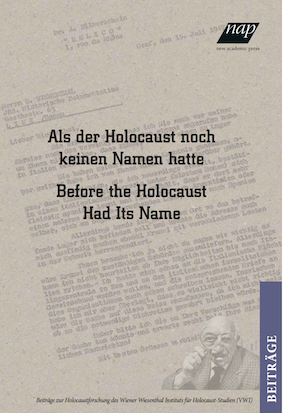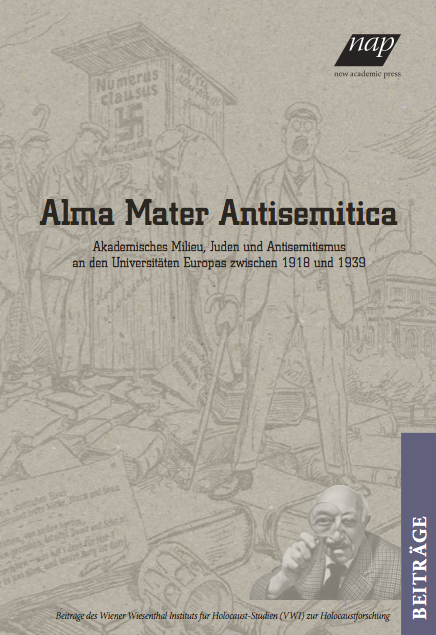 Historical research has surprisingly until now largely ignored the activities of accredited foreign correspondents in Berlin during the ‘Third Reich’. Instead it has focused almost exclusively on ‘the other side’ of journalism, the state public relations and propaganda apparatus. This is even more surprising taking into consideration that foreign correspondents working in Berlin contributed to the international image of National Socialist Germany.
Historical research has surprisingly until now largely ignored the activities of accredited foreign correspondents in Berlin during the ‘Third Reich’. Instead it has focused almost exclusively on ‘the other side’ of journalism, the state public relations and propaganda apparatus. This is even more surprising taking into consideration that foreign correspondents working in Berlin contributed to the international image of National Socialist Germany.
By researching foreign correspondents working in the ‘Third Reich’ we can discover numerous new insights into the transnational perception of National Socialist Germany; not only through the extremes of rejection and approval the regime received internationally, but also fundamentally through the significance given in journalistic everyday life to news and commentary from National Socialist Germany.
To date only a few individual biographies on foreign correspondents working at that time exist, although many of them wrote memoires soon after they were foreign correspondents and a surprising number of bequests have been preserved. Alongside these, classic state documents and records have been passed on. By interpreting these records of state propaganda attempts from a critical distance and comparing them with the testimonials of foreign correspondents especially from the United States, Great Britain and France, it is possible to create a comprehensive analysis of their work. It will cover their investigations, often using the assistance of local informants and stringers, their text production and the reception of printed articles and radio broadcasts in their home countries and worldwide.
Until its downfall the ‘Third Reich’ wooed, persuaded, deceived and threatened its foreign correspondents. If all means of ‘direction’, ‘prescribed terminology’ and ‘press control’ failed, the regime did not hesitate to isolate, imprison and expel foreign journalists. Nevertheless, they remained a power which the National Socialist regime from a media historical perspective took account of in a modern way until the very end: different from the public spheres of the Allies it never formally introduced pre-censorship, except for radio broadcasts. This is yet another reason to focus on foreign correspondents in the ‘Third Reich’ as independent creators of and actors in media events.
Editorial
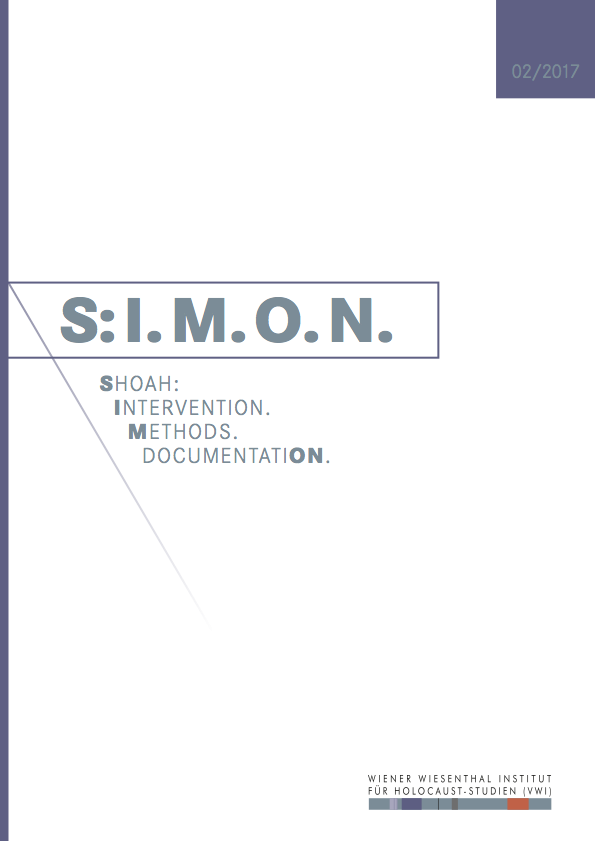 S:I.M.O.N. is an e-journal of the Vienna Wiesenthal Institute for Holocaust Studies (VWI). It appears twice a year in English and German language. S:I.M.O.N. aims at both a transnational and comparative history of the Holocaust and Jewish Studies in Central and Eastern Europe within the broader contexts of the European history of the 20th and 21st century, including its prehistory, consequences and legacies as well as the history of memory.
S:I.M.O.N. is an e-journal of the Vienna Wiesenthal Institute for Holocaust Studies (VWI). It appears twice a year in English and German language. S:I.M.O.N. aims at both a transnational and comparative history of the Holocaust and Jewish Studies in Central and Eastern Europe within the broader contexts of the European history of the 20th and 21st century, including its prehistory, consequences and legacies as well as the history of memory.
S:I.M.O.N. serves as a forum for discussion of various methodological approaches. The journal especially wishes to strengthen the exchange between researchers from different scientific communities and to integrate both the Jewish history and the history of the Holocaust into the different “national” narratives. It also lays a special emphasis on memory studies and the analysis of politics of memory. S:I.M.O.N. uses a double-blind review system, which means that both the reviewer’s and the author’s identities are concealed from each other hroughout the review process.
Shoah: The journal deals with the history of the Shoah from multidisciplinary, transnational and comparative perspectives. It seeks to integrate studies on Jews as well as on other groups of victims of the Holocaust, especially on Roma, and of so far less researched regions of (East) Central and (South) Eastern Europe.
Intervention. The journal reports on research projects and their transmission into public events. It also informs about current educational and remembrance programs.
Methods. The journal serves as a forum for the discussion of methodological approaches as, for instance, the everyday history, oral history, gender history, the history of violence, anti-Semitism and racism and the theory of memory and memory politics.
DocumentatiON. The journal contributes to critical approaches on using and interpreting archival materials in the 21st century.
Download the current issue S:I.M.O.N. 2017/2.
Articles
Alexander Korb
Transformationsgewalt in Europa 1944–1950. Perspektiven auf das Ende des Zweiten Weltkriegs
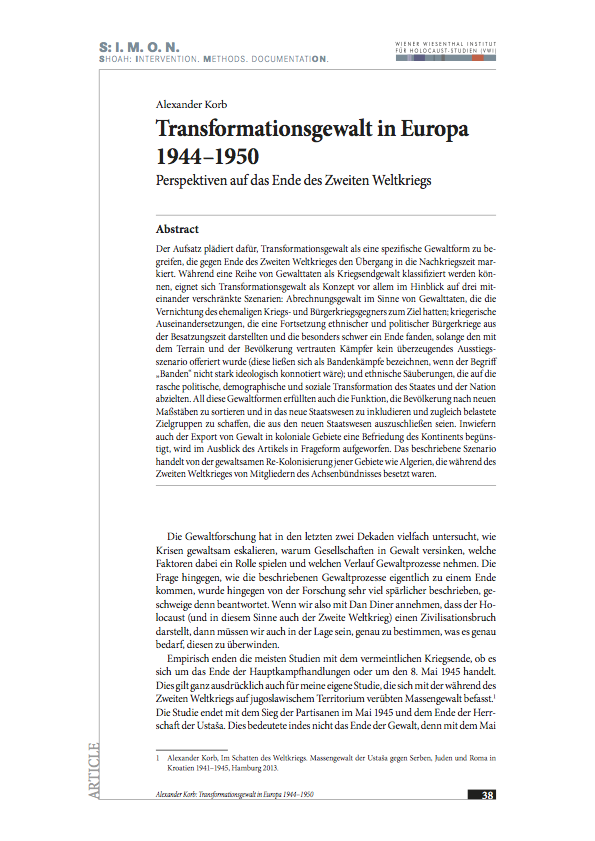 This essay proposes that transformation violence be considered a particular form of violence that marked the transition to the post-war period towards the end of the Second World War. While a series of violent acts can be classified as wartime violence, transformation violence is a useful concept that can be applied in particular to three interlocked scenarios: settlement violence, meaning violent acts that aimed to destroy the former enemy in war and civil war; acts of war that constituted a continuation of ethnic and political civil wars from the occupation era and which were particularly hard to put to an end as long as the fighters familiar with the territory and the population were not given a convincing exit scenario (these might be described as gang wars if the term “gangs” did not carry such a strong ideological connotation); lastly, ethnic cleansing that aimed at a rapid political, demographic and social transformation of the state and the nation. These forms of violence all also had the purpose of arranging the population by new measures and to draw them into the new political system while at the same time creating loaded target groups who were to be excluded from the new political system. Finally, the article raises the question whether the export of violence into colonial territories aided the peacemaking efforts on the continent. It describes the scenario of violent re-colonialisation of territories like Algeria, which had been occupied by members of the axis powers during the Second World War.
This essay proposes that transformation violence be considered a particular form of violence that marked the transition to the post-war period towards the end of the Second World War. While a series of violent acts can be classified as wartime violence, transformation violence is a useful concept that can be applied in particular to three interlocked scenarios: settlement violence, meaning violent acts that aimed to destroy the former enemy in war and civil war; acts of war that constituted a continuation of ethnic and political civil wars from the occupation era and which were particularly hard to put to an end as long as the fighters familiar with the territory and the population were not given a convincing exit scenario (these might be described as gang wars if the term “gangs” did not carry such a strong ideological connotation); lastly, ethnic cleansing that aimed at a rapid political, demographic and social transformation of the state and the nation. These forms of violence all also had the purpose of arranging the population by new measures and to draw them into the new political system while at the same time creating loaded target groups who were to be excluded from the new political system. Finally, the article raises the question whether the export of violence into colonial territories aided the peacemaking efforts on the continent. It describes the scenario of violent re-colonialisation of territories like Algeria, which had been occupied by members of the axis powers during the Second World War.
SWL-Reader
Nóra Berend
Jews and the Hungarian State. Integrative and Exclusionary Models from Medieval to Modern Times
 In Hungary, official memory and history discourses often distinguish between ‘Jews’ and ‘Hungarians’, harking back to the Horthy-era concept of the ‘Christian national’ state. This dichotomy clashes with modern ideas of citizenship and acts as a carrier of antisemitism. This lecture analyses the role of political authority in fostering integration or exclusion over a long time span. It begins with the attitudes of those holding political power in the Kingdom of Hungary in the Middle Ages, when the distinction between Jews and Christians was based on religious affiliation. In particular, two processes will be examined: one leading to increased integration, granting protection and rights, and the other promoting segregation, demonisation and hostility. The lecture will then focus on key moments in modern history, exploring the functions of these two contradictory but related processes. It will finally tackle the question of the role of the state in (dis)continuities between medieval exclusion and modern antisemitism.
In Hungary, official memory and history discourses often distinguish between ‘Jews’ and ‘Hungarians’, harking back to the Horthy-era concept of the ‘Christian national’ state. This dichotomy clashes with modern ideas of citizenship and acts as a carrier of antisemitism. This lecture analyses the role of political authority in fostering integration or exclusion over a long time span. It begins with the attitudes of those holding political power in the Kingdom of Hungary in the Middle Ages, when the distinction between Jews and Christians was based on religious affiliation. In particular, two processes will be examined: one leading to increased integration, granting protection and rights, and the other promoting segregation, demonisation and hostility. The lecture will then focus on key moments in modern history, exploring the functions of these two contradictory but related processes. It will finally tackle the question of the role of the state in (dis)continuities between medieval exclusion and modern antisemitism.
Events
Zoltán Halasi
Duschehubka
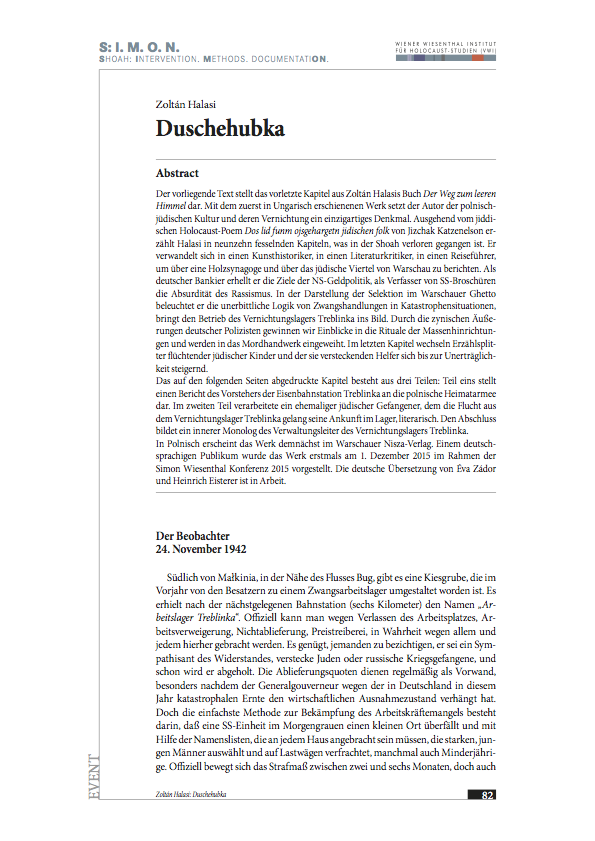 This text is the penultimate chapter of Zoltán Halasi's book Út az üres éghez (Road to an Empty Sky). With this work, which was first published in Hungarian, the author created a singular memorial to Polish-Jewish culture and its destruction. Setting out from the Yiddish Holocaust poem Dos lid funm ojsgehargetn jidischen folk by Itzhak Katzenelson, Halasi records what was lost in the Shoah in the course of nineteen compelling chapters. He takes on the grab of an art historian, a literary critic and a travel guide when he reports about a wooden synagogue and the Jewish quarter in Warsaw. In the role of a German banker, he illuminates the aims of the Nazi monetary policies, as a writer of SS brochures he highlights the absurdity of racism. Depicting a Selektion in the Warsaw ghetto, he shows the grim logic of compulsive acts in catastrophic situations, draws an image of the running of the extermination camp Treblinka. The cynical words of two German policemen provide an insight into the rituals of mass executions and introduce us to the craft of murder. The final chapter is an interplay of slithers of narrative by Jewish children on the run and by those who helped and hid them that borders on the unbearable.
This text is the penultimate chapter of Zoltán Halasi's book Út az üres éghez (Road to an Empty Sky). With this work, which was first published in Hungarian, the author created a singular memorial to Polish-Jewish culture and its destruction. Setting out from the Yiddish Holocaust poem Dos lid funm ojsgehargetn jidischen folk by Itzhak Katzenelson, Halasi records what was lost in the Shoah in the course of nineteen compelling chapters. He takes on the grab of an art historian, a literary critic and a travel guide when he reports about a wooden synagogue and the Jewish quarter in Warsaw. In the role of a German banker, he illuminates the aims of the Nazi monetary policies, as a writer of SS brochures he highlights the absurdity of racism. Depicting a Selektion in the Warsaw ghetto, he shows the grim logic of compulsive acts in catastrophic situations, draws an image of the running of the extermination camp Treblinka. The cynical words of two German policemen provide an insight into the rituals of mass executions and introduce us to the craft of murder. The final chapter is an interplay of slithers of narrative by Jewish children on the run and by those who helped and hid them that borders on the unbearable.
The chapter reproduced on the following pages has three parts: Part one is a Treblinka railway station master's report to the Polish Home Army. In the second part, a former Jewish detainee who managed to escape from the extermination camp Treblinka gives a literary treatment of his arrival at the camp. The final part consists of an inner monologue by the Treblinka extermination camp's director of administration.
The book will shortly be published in Polish at the Nisza publishing company in Warsaw. The German-speaking public was first presented with the work on December 1, 2015 at the Simon Wiesenthal Conference 2015. The German translation by Éva Zádor and Heinrich Eisterer is in progress.
Norman Domeier: Zwischen investigativer Recherche und Kollaboration. Ausländische Journalisten im ,Dritten Reich‘
„... zu lesen, wenn alles vorüber ist“
Rita Maria Rockenbauer, Briefe 1938 –1942
Wien 2014
Partituren der Erinnerung.
Der Holocaust in der Musik
Scores of Commemoration.
The Holocaust in Music
Wien 2015
Before the Holocaust Had Its Name. Early Confrontations of the Nazi Mass Murder of the Jews
Wien 2016
Akademisches Milieu, Juden und Antisemitismus an den Universitäten Europas zwischen 1918 und 1939
Academic Milieu, Jews and Antisemitism at European Universities between 1918 and 1939
Wien 2016


